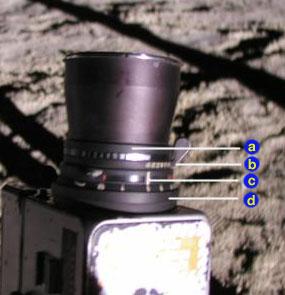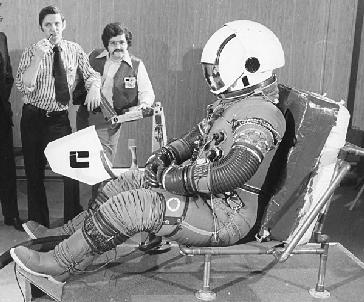space suit







|
|
Fig. 1 shows the lens controls on the Zeiss Biogon wide-angle lens fitted to the Apollo Hasselblad camera. The exposure and focus rings were fitted with paddles to allow an astronaut simply to press them with a finger and rotate the ring appropriately. The focus ring featured detents for zone focusing.
 The EVA suits for the
space shuttle have visible joints to allow for movement. The Apollo
suits have no such joints. Without them the suits would have been
impossible to flex.
The EVA suits for the
space shuttle have visible joints to allow for movement. The Apollo
suits have no such joints. Without them the suits would have been
impossible to flex.
There is no doubt that space suit design has come a long way in thirty years. Today's space suits are very different in some ways from the Apollo suits.
The Apollo suit was constructed of several layers. The outer layers were various types of cloth and insulation which were naturally flexible. The layer of interest is the pressure garment, which is the predictable inflated airtight bladder. Far from a simple balloon of rubber, it featured accordion joints at the knees and elbows, and swivel joints at the shoulders to provide the necessary range of motion. These are the same features as the shuttle suits. They're just covered up by fabric in the Apollo design.
|
 If
the suits were pressurized in a vacuum they should bulge out. But we
never see them where they look inflated.
If
the suits were pressurized in a vacuum they should bulge out. But we
never see them where they look inflated.
To the experienced eye there is a visible difference between a pressurized suit and a deflated suit. But at the same time, the suit designers provided a "restraint layer". The suit did not need to bulge in order to be effective. It merely had to contain a volume of air around the astronaut's body. But in order to do that and still be flexible it would have to be made from some material like neoprene which is both flexible and airtight. The tendency of these materials to stretch when inflated is a problem, not a desired effect. So the suit was allowed to balloon a little bit in order to provide the right environment for the astronaut, but it was kept from bulging as far as it wanted to go because that poses problems for flexibility and for fitting through hatches and moving about inside the spacecraft.
The restraint layer was simply a web of nonstretch netting integrated into the suit's pressure garment (the Neoprene part). As the pressure garment expanded, it could expand only until the netting was taut. Imagine blowing up a balloon in a small fish net.



